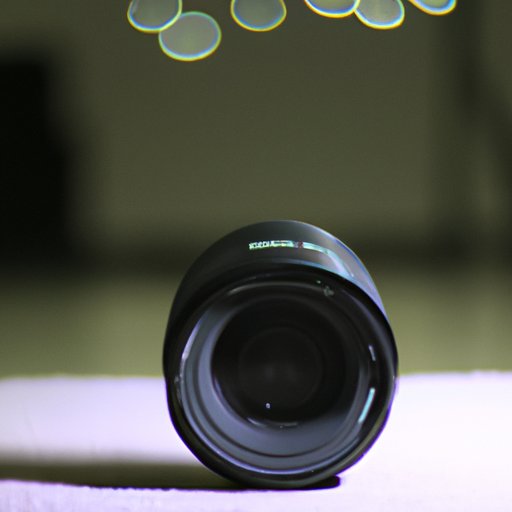Introduction
Prime lenses have become increasingly popular among photographers due to their versatility and ability to capture stunning images. But what are prime lenses and why should you consider using them? In this article, we’ll explore what prime lenses are and the benefits they can offer photographers.

A Guide to Understanding Prime Lenses for Photographers
Prime lenses are fixed focal length lenses that do not zoom. They are typically more compact than zoom lenses and offer excellent image quality and sharpness. Because of their fixed focal length, they are often referred to as “fixed-focal-length” or “prime” lenses.
Advantages of prime lenses include an increased maximum aperture, which allows more light to enter the camera and provides more creative control over depth of field. Additionally, they tend to be lighter and more affordable than zoom lenses.
There are a variety of different types of prime lenses available, including wide-angle, normal, telephoto, and macro. Each type has its own unique characteristics and can be used for different types of photography, such as landscapes, portraits, and close-ups.

An Introduction to Prime Lenses and How They Can Improve Your Photography
Understanding the basics of prime lenses can help you make the most of your photography. Let’s take a look at some of the key features of prime lenses and how they can help you capture better photos.
Lens Aperture: The aperture of a prime lens is the size of the opening through which light passes. A larger aperture (measured in f-stops) means more light can enter the lens and allows you to use faster shutter speeds and lower ISO settings. This increases the potential for sharper images and greater control over depth of field.
Focal Length: Focal length is the distance between the lens and the film or digital sensor. A shorter focal length gives a wider angle of view, while a longer focal length gives a narrower angle of view. Prime lenses come in a wide range of focal lengths, so you can choose the one that best suits your needs.
Image Quality: Prime lenses are known for their superior image quality compared to zoom lenses. This is because they don’t need to move any of their components to change the focal length, resulting in less distortion and higher resolution. Additionally, they tend to have fewer aberrations and chromatic aberration than zoom lenses.
Taking Your Photography to the Next Level with Prime Lenses
Prime lenses can be used to take your photography to the next level. Here are some of the ways they can help you improve your photos.
Depth of Field: Prime lenses have a large maximum aperture, which allows you to achieve a shallow depth of field. This means you can blur out the background of your photos, making the subject stand out and creating a more professional look.
Low Light Performance: Prime lenses allow you to use faster shutter speeds and lower ISO settings in low light conditions. This results in less noise and sharper images, allowing you to capture better photos even in challenging lighting situations.
Creative Possibilities: Prime lenses offer a wide range of creative possibilities. You can use them to create interesting bokeh effects, isolate subjects, and experiment with different perspectives.
What You Need to Know About Prime Lenses Before Purchasing
Before purchasing a prime lens, there are a few things you should consider. Here are some of the key factors to keep in mind.
Cost: Prime lenses tend to be more expensive than zoom lenses. However, if you’re looking for superior image quality and creative control, they can be a worthwhile investment.
Compatibility: Make sure the prime lens you purchase is compatible with your camera system. Most lenses are designed for specific camera systems, so it’s important to check before buying.
Weight: Prime lenses are typically smaller and lighter than zoom lenses, making them easier to carry around. However, if you’re planning on doing a lot of hand-held shooting, a heavier lens may be more suitable.

How to Choose the Right Prime Lens for Your Needs
Now that you know the basics of prime lenses, it’s time to start shopping. Here are some tips to help you choose the right one for your needs.
Consider Your Subject Matter: Think about what type of photography you plan to do and select a lens accordingly. For example, if you plan to shoot landscapes, a wide-angle prime lens might be a good choice.
Consider Your Budget: Prime lenses can be expensive, so make sure you set a budget before you start shopping. There are plenty of options available at different price points, so you should be able to find something within your budget.
Consider Your Camera System: Make sure the prime lens you select is compatible with your camera system. This will ensure you get the best possible performance from your lens.
Conclusion
Prime lenses offer a wealth of advantages for photographers. They provide excellent image quality and sharpness, as well as increased creative control over depth of field. Additionally, they are generally smaller, lighter, and more affordable than zoom lenses.
When selecting a prime lens, it’s important to consider your subject matter, budget, and camera system. Doing so will help ensure you get the best possible performance from your lens.
So if you’re looking for a way to take your photography to the next level, prime lenses are an excellent choice. With the right lens, you can capture stunning images and create unique looks that will make your photos stand out.
(Note: Is this article not meeting your expectations? Do you have knowledge or insights to share? Unlock new opportunities and expand your reach by joining our authors team. Click Registration to join us and share your expertise with our readers.)
